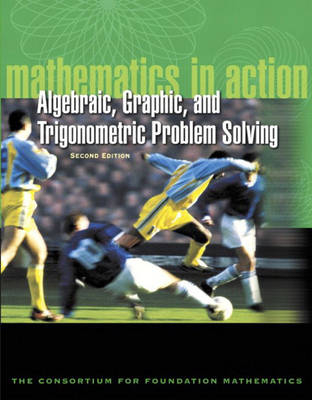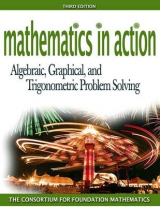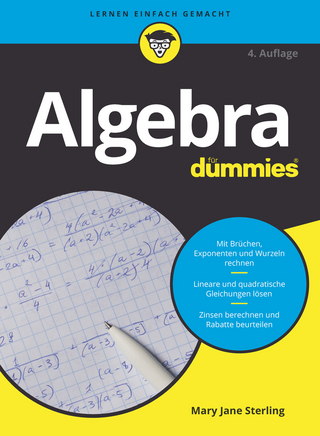
Mathematics in Action
Pearson (Verlag)
978-0-321-14920-6 (ISBN)
- Titel erscheint in neuer Auflage
- Artikel merken
(Note: Each cluster ends with a “What Have I Learned?” and a “How Can I Practice?” Each chapter ends with a Concepts and Skills Summary and a Chapter Gateway.)
1. Function Sense and Linear Functions.
Cluster 1: Introduction to Functions.
Activity 1.1. Parking Problems.
Objectives:
Define a function.
Represent a function numerically and graphically.
Write a function using function notation.
Distinguish between input and output.
Activity 1.2. Fill 'Er Up.
Objectives:
Determine the equation (symbolic representation) that defines a function.
Write the equation to define a function.
Determine the domain and range of a function.
Identify the independent and the dependent variables of a function.
Activity 1.3. Stopping Short.
Objectives:
Use a function as a mathematical model.
Determine when a function is increasing, decreasing or constant.
Use the vertical line test to determine if a graph represents a function.
Activity 1.4. Graphs Tell Stories.
Objectives:
Describe in words what the graph is telling you about a given situation.
Sketch a graph that best represents a given situation described in words.
Cluster 2: Linear Functions.
Activity 1.5. Walking for Fitness.
Objective: Determine the average Rate of Change.
Activity 1.6. Depreciation.
Objectives:
Discover slope as it applies to rate of change.
Use the formula to determine slope.
Discover the practical meaning of vertical and horizontal intercepts.
Develop the slope/intercept form of an equation of a line.
Use slope/intercept formula to determine vertical and horizontal intercepts.
Activity 1.7. A Visit to the Architect.
Objectives:
Determine the slope intercept form of a line given the slope and vertical intercept.
Determine the slope intercept form of a line given two points on the line.
Activity 1.8. SkateBoard Heaven.
Objectives:
Write an equation of a line in general form Ax + By = C.
Write the slope-intercept form of a linear equation given the general form.
Activity 1.9. College Tuition.
Objectives:
Determine a line of best fit with a straightedge.
Determine the equation of a regression line using a graphing calculator.
Use the regression equation to interpolate and extrapolate.
Cluster 3: Systems of Linear Equations and Absolute Value Functions.
Activity 1.10. Ride for Less.
Objectives:
Solve a system of 2x2 linear equations numerically and graphically.
Solve a system of 2x2 linear equations using the substitution method.
Solve an equation of the form ax + b = cx + d for x.
Activity 1.11. Healthy Life-Style.
Objectives:
Solve a 2x2 Linear System algebraically using the substitution method and the addition method.
Solve equations containing parenthesis.
Activity 1.12. Sam's Café.
Objective: Solve a 3x3 linear system of equations.
Activity 1.13. How Long Can You Live?
Objectives:
Solve linear inequalities numerically and graphically.
Use properties of inequalities to solve linear inequalities algebraically.
Solve compound inequalities algebraically and graphically.
Activity 1.14. Long Distance by Phone.
Objectives:
Graph a piecewise linear function.
Write a piecewise linear function to represent a given situation.
Activity 1.15. How Much Can You Tolerate?
Objectives:
Write a compound inequality to represent a given statement.
Determine the error.
Solve an equation involving absolute value using a number line.
Solve an inequality involving absolute value using a number line.
Solve absolute value equations and inequalities using a graphing approach.
Interpret absolute value as distance.
Graph an absolute value function.
2. The Algebra of Functions.
Cluster 1: Addition, Subtraction, and Multiplication of Functions.
Activity 2.1. Spending and Earning Money.
Objectives:
Identify a polynomial expression.
Identify a polynomial function.
Add and subtract polynomial expressions.
Add and subtract polynomial functions.
Activity 2.2. Viewing the Algebra of Functions.
Objective: Explore adding and subtracting functions graphically.
Activity 2.3. How Does Your Garden Grow?
Objectives:
Multiply two binomials using the FOIL method.
Multiply two polynomial functions.
Apply property of exponents to multiply powers having the same base.
Activity 2.4. Star Gazing.
Objectives:
Convert decimal notation to scientific notation.
Convert scientific notation to decimal notation.
Apply the property of exponents to divide powers having the same base.
Apply the property of exponents a0 = 1, a 0.
Apply the property of exponents a -n = 1/an, a 0, n any real number.
Cluster 2: Composition and Inverse of Functions.
Activity 2.5. Inflated Balloons.
Objectives:
Determine the composition of two functions.
Explore the relationship between f(g(x)) and g(f(x)).
Activity 2.6. Finding a Bargain.
Objective: Solve problems using the composition of functions.
Activity 2.7. The Square of a Cube.
Objectives:
Apply property of exponents to simplify an expression involving a power to a power.
Apply property of exponents to expand the power of a product.
Determine the nth root of a real number.
Write a radical as a power having a rational exponent and vice versa.
Activity 2.8. Study Time.
Objectives:
Determine the inverse of a function represented by a table of values.
Use the notation -1.
Use the property (-1(x)) = -1((x)) = x to recognize inverse functions.
Determine the domain and range of a function and its inverse.
Activity 2.9. Temperature Conversions.
Objectives:
Determine the equation of the inverse of a function represented by an equation.
Describe the relationship between the graphs of inverse functions.
Determine the graph of the inverse of a function represented by a graph.
Use the graphing calculator to produce graphs of an inverse function.
3. Exponential and Logarithmic Functions.
Cluster 1: Exponential Functions.
Activity 3.1. The Summer Job.
Objectives:
Determine the growth or decay factor of an exponential function.
Identify the properties of the graph of an exponential function defined by y = bx, b > 0, b 1.
Graph an exponential function.
Activity 3.2. Cellular Phones.
Objectives:
Determine the growth and decay factor for an exponential function represented by a table of values or an equation.
Graph exponential functions defined by y = abx, b > 0, b 1.
Determine the doubling and halving time.
Activity 3.3. Population Growth.
Objectives:
Determine annual growth or decay rate of an exponential function represented by a table of values or an equation.
Graph an exponential function having equation y = a(1 + r)x.
Project Activity 3.4. Photocopying Machines.
Objectives:
Generate date given the growth or decay rate of an exponential function.
Write exponential functions given the growth or decay rate.
Graph exponential functions from data.
Determine doubling and halving times from exponential functions.
Activity 3.5. Compound Interest.
Objectives:
Apply the compound interest and continuous compounding formulas to a given situation.
Graph base e exponential functions.
Solve problems involving continuous growth and decay models.
Activity 3.6. College Graduates.
Objectives:
Determine the equation of an exponential function that best fits the given data.
Make predictions using an exponential regression equation.
Determine whether a line or exponential model best fits the data.
Cluster 2: Logarithmic Functions.
Activity 3.7. The Diameter of Spheres.
Objectives:
Define logarithm.
Change an exponential function to logarithmic form.
Change a logarithmic function to exponential form.
Determine log and ln using the calculator.
Activity 3.8. Walking Speed of Pedestrians.
Objectives:
Determine the inverse of the exponential functions.
Identify properties of the graph of se of the exponential functions.
Identify properties of the graph of y = logx.
Identify the properties of the graph of a logarithmic function.
Graph the natural logarithmic function.
Activity 3.9. Walking Speed of Pedestrians Continued.
Objectives:
Compare the average rate of change of increasing logarithmic, linear, and exponential functions.
Determine the regression equation of a natural logarithmic function that best fits a set of data.
Activity 3.10. The Elastic Ball.
Objectives:
Apply log of a product property.
Apply log of a quotient property.
Apply log of a power property.
Discover change of base formula.
Activity 3.11. Prison Growth.
Objective: Solve exponential equations both graphically and algebraically.
Activity 3.12. Frequency and Pitch.
Objective: Solve logarithmic equations both graphically and algebraically.
4. Quadratic and Higher Order Polynomial Functions.
Cluster 1: Introduction to Quadratic Functions.
Activity 4.1. Baseball and the Sears Tower.
Objectives:
Identify functions of the form f(x) = ax² + bx + c as quadratic functions.
Explore the roles of a as it relates to the graph of f(x) = ax² + bx + c.
Explore the role of b as it relates to the graph of f(x) = ax² + bx + c.
Explore the role of c as it relates to the graph of f(x) = ax² + bx + c.
Activity 4.2. The Shot Put.
Objectives:
Determine the vertex or turning point of a parabola.
Determine the axis of symmetry of a parabola.
Identify the domain and range.
Determine the vertical-intercept of a parabola.
Determine the horizontal-intercept(s) graphically.
Activity 4.3. Per Capita Personal Income.
Objectives:
Solve quadratic equations graphically.
Solve quadratic equations numerically.
Solve quadratic inequalities graphically.
Activity 4.4. Sir Isaac Newton.
Objectives:
Factor expressions by removing the greatest common factor.
Factor trinomials using trial and error.
Use the zero-product principle to solve equations.
Solve quadratic equations by factoring.
Activity 4.5. Motorcycle Deaths.
Objective: Solve Quadratic Equations by the Quadratic Formula.
Activity 4.6. Air Quality in Atlanta.
Objectives:
Determine quadratic regression models using the graphing calculator.
Solve problems using quadratic regression models.
Cluster 2: Complex Numbers and Problem Solving Using Quadratic Functions.
Activity 4.7. Complex Numbers.
Objectives:
Identify the imaginary unit i = -1.
Identify a complex number.
Determine the value of the discriminant b² - 4ac.
Determine the types of solutions to a quadratic equation.
Solve a quadratic equation in the complex number system.
Activity 4.8. Airfare.
Objectives:
Build a Quadratic Model as a Product of Linear Models.
Analyze a Model Contextually.
Project Activity 4.9. Chemical Waste Holding Region.
Objective: Problem Solving Using Quadratic Functions.
Cluster 3: Curve Fitting and Higher Order Polynomial Functions.
Activity 4.10. The Power of Power Functions.
Objectives:
Identify a direct variation function.
Determine the constant of variation.
Identify the properties of graphs of power functions defined by y = kxn, n is a positive integer.
Activity 4.11. Hot Air Balloon.
Objectives:
Identify equations that define polynomial functions.
Determine the degree of a polynomial function.
Determine the intercepts of the graph of a polynomial function.
Identify the properties of the graphs of polynomial functions.
Activity 4.12. Stolen Bases.
Objective: Determine the regression equation of a polynomial function that best fits the data.
Project Activity 4.13. Finding the Maximum Value.
Objective: Problem solving using polynomial functions.
5. Rational and Radical Functions.
Cluster 1: Rational Functions.
Activity 5.1. Speed Limits.
Objectives:
Determine the domain and range of a function defined by y = k/x, k is a nonzero real number.
Determine the vertical and horizontal asymptotes of the graph of y = k/x.
Sketch a graph of functions of the form y = k/x.
Determine the properties of graphs of the form y = k/x.
Activity 5.2. Loudness of a Sound.
Objectives:
Graph of inverse variation function defined by an equation of the form y k/xn, n is any positive integer.
Describe the properties of graphs of the form y k/nxn.
Determine the constant of proportionality.
Activity 5.3. Percent Markup.
Objectives:
Determine the domain of a rational function defined by an equation of the form y k/g(x) k a nonzero constant and g(x) a polynomial expression.
Identify the vertical and horizontal asymptotes of y = k/g(x).
Sketch a graph of rational functions defined by y = k/g(x).
Activity 5.4. Blood-Alcohol Levels.
Objectives:
Solve an equation involving a rational expression using an algebraic approach.
Solve an equation involving a rational expression using a graphing approach.
Determine horizontal asymptotes of the graph of y = f(x)/g(x), where f(x) and g(x) are first degree polynomials.
Activity 5.5. Traffic Flow.
Objectives:
Determine the least common denominator (LCD) of two or more rational expressions.
Solve an equation involving rational expressions using an algebraic approach.
Solve a formula for a specific letter.
Activity 5.6. Electrical Circuits.
Objectives:
Add and subtract rational expressions.
Simplify a complex fraction.
Cluster 2: Radical Functions and Equations.
Activity 5.7. Hang Time.
Objectives:
Determine the domain of a radical function defined by y = g(x), g(x) a polynomial.
Graph functions of the form y = g(x) and y = g(x).
Identify the properties of the graph of y = g(x) and y = g(x).
Activity 5.8. Falling Objects.
Objective: Solve an equation involving a radical expression using a graphical and algebraic approach.
Activity 5.9. Propane Tank.
Objectives:
Determine the domain of a function defined by an equation of the form y = n g(x) n is a positive integer and g(x) is a polynomial.
Graph y = n g(x).
Identify the properties of graphs of n g(x).
Solve radical equations that contain radical expressions with Index other than 2.
6. An Introduction to the Trigonometric Functions.
Cluster 1: Introducing the Sine, Cosine, and Tangent Functions.
Activity 6.1. The Leaning Tower of Pisa.
Objectives:
Identify the sides and corresponding angles of a right triangle.
Determine the length of the sides of similar right triangles using proportions.
Determine the sine, cosine, and tangent of an angle using a right triangle.
Activity 6.2. A Gasoline Problem.
Objectives:
Identify complementary angles.
Demonstrate that the sine and cosine of complementary angles are equal.
Activity 6.3. The Sidewalks of New York.
Objectives:
Determine the inverse tangent of a number.
Determine the inverse sine and cosine of a number.
Identify the domain and range of the inverse sine, cosine, and tangent functions.
Activity 6.4. Solving a Murder.
Objective: Determine the measure of all sides and all angles of a right triangle.
Activity 6.5. How Stable is That Tower?
Objective: Solve problems using right triangle trigonometry.
Project Activity 6.6. Seeing Abraham Lincoln.
Objective: Solving optimization problems using right triangle trigonometry and by analyzing graphs.
Cluster 2: Why are the Trigonometric Functions Called Circular?
Activity 6.7. Learn Trigonometry or Crash!
Objectives:
Determine the coordinates of points on a unit circle using sine and cosine functions.
Sketch a graph of y = sin x and y = cos x.
Identify the properties of the graphs of the sine and cosine functions.
Activity 6.8. It Won't Hertz.
Objectives:
Convert between degree and radian measure.
Identify the period and frequency of a function defined by y = a sin(bx) or y = a cos(bx) using the graph.
Activity 6.9. Get In Shape.
Objective: Determine the amplitude of the graph of y = a sin(bx) or y = a cos(bx).
Activity 6.10. Speeding Up.
Objective: Determine the period of the graph of y a sin(bx) and y = a cos(bx) using a formula.
Activity 6.11. Running With a Friend.
Objective: Determine the displacement of and y = a sin (bx + c) and y a cos (bx + c) using a formula.
Appendix A. Concept Review.
Appendix B. Trigonometry.
Appendix C. The TI-83 Plus Graphing Calculator.
Selected Answers.
Glossary.
Index.
| Erscheint lt. Verlag | 7.6.2004 |
|---|---|
| Sprache | englisch |
| Maße | 214 x 275 mm |
| Gewicht | 1678 g |
| Themenwelt | Mathematik / Informatik ► Mathematik ► Algebra |
| Mathematik / Informatik ► Mathematik ► Geometrie / Topologie | |
| ISBN-10 | 0-321-14920-3 / 0321149203 |
| ISBN-13 | 978-0-321-14920-6 / 9780321149206 |
| Zustand | Neuware |
| Haben Sie eine Frage zum Produkt? |
aus dem Bereich



